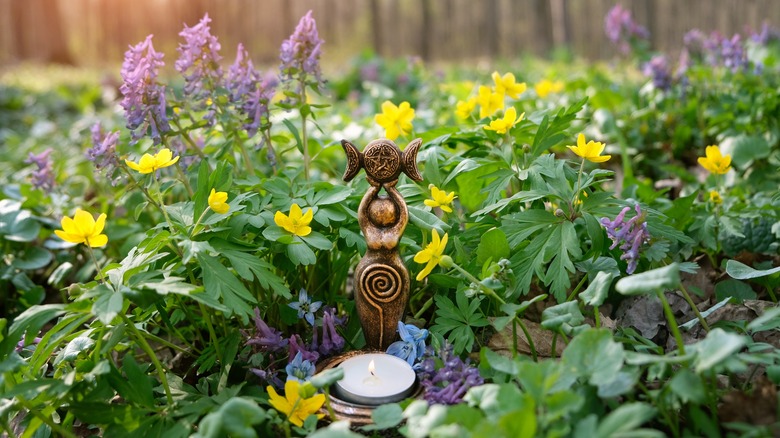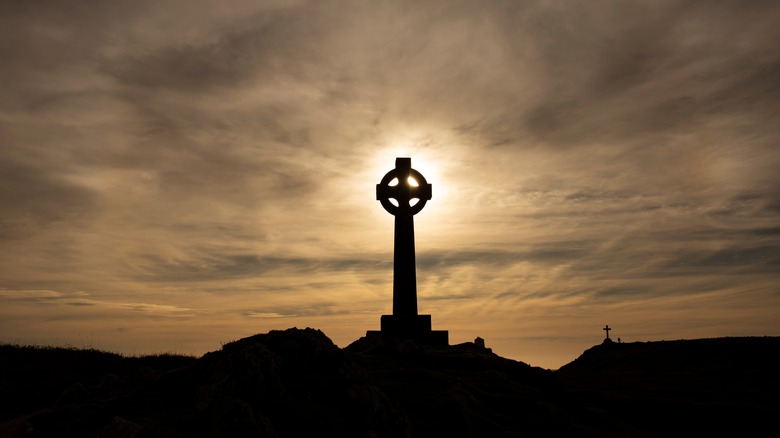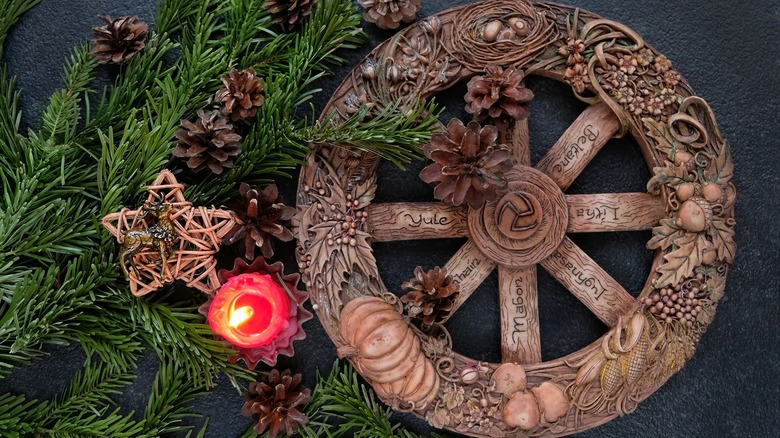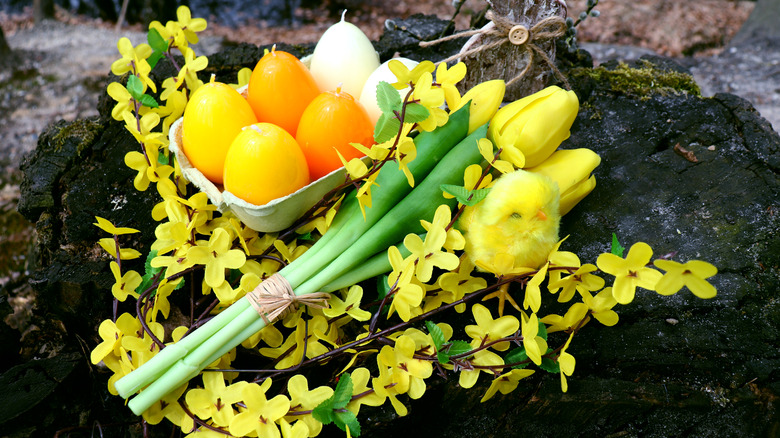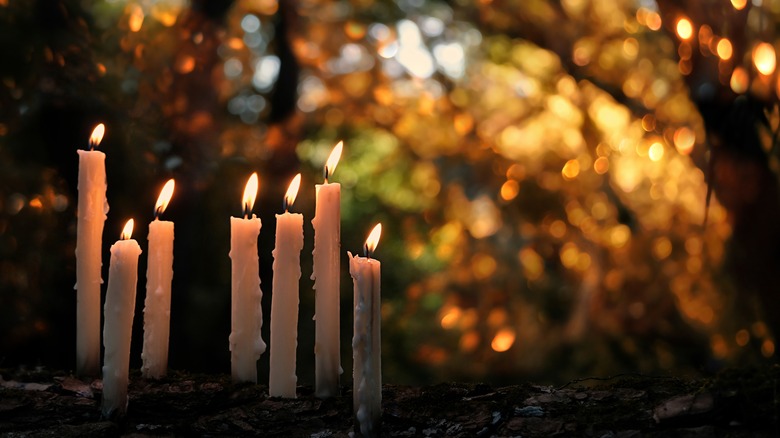The Origins Of The 8 Witch's Sabbaths Explained
Many world religions share certain common features: prominent people who establish a faith, central god figures whom the faith honors, defined rituals of propitiation and commune with the divine or transcendent, dictums about conduct, rules about language, and even codes about food and clothing. But there's a far more fundamental aspect of mystical customs that long predates entanglements of modern theology: the seasonal cycle. It's no accident that many religious holidays often coincide with solar events, as Learn Religions says of the winter solstice.
Go back far enough in time, and all spiritual experience just might return to one singularity: "sympathetic magic," i.e., influence nature by doing action a, b, or c. Cave paintings — the earliest human art — are sometimes described as sympathetic magic because they feature pictures of animals presumably to understand them, catalog them, and in a sense, control them, as PBS explains. Long before meat came shrink-wrapped in the freezer section of the grocery store humanity was, by necessity, far more connected to seasonal cycles, animal reproductive cycles, vegetative growth cycles, weather systems, and so forth.
This is where "Witch's Sabbaths" come into play. The eight Sabbaths — often spelled "Sabbats" — are an attempt on the part of modern-day pagans, neo-pagans, heathens — take your pick of term — to reconnect with nature by stationing holy days at intervals throughout the calendar year. In so doing, they borrow from the old to make something new and take inspiration from a variety of ancient traditions.
Ancient traditions blended into something new
We've no doubt that "witch" combined with "Sabbath" or "Sabbat" is going to make some people scratch their heads. Ultimately, that's a happy byproduct. The modern heathen adoption of the term "Sabbath" — a weekly day of rest — is an attempt to destigmatize pre-Christian beliefs that, as Britannica explains, show up in "Inquisition records" dating back to the 14th century. It's no secret that the Catholic and Protestant churches haven't been historically kind to "witches" in their midst, i.e., people commonly characterized as "wise women" of the countryside who uses folk magic and herbs in everyday life, as History outlines. From 1500 to 1660 alone, as many as 80,000 such people — both men and women — were slaughtered by the church in regular witch hunts.
But even centuries before then, folk magic of the heath — practiced by heath-ens — had receded out of sight. Clear and direct throughlines between old, pre-Christian practices and modern interpretations of those practices are impossible to follow. That is until we get to recent history. Modern Witch's Sabbats took form with Wicca, a modern 1940s invention born of a whole bunch of esoteric influences that more or less take root in nature reverence, per History. But, the Sabbats aren't exclusively Wiccan. As Alemanaka explains, the eight Sabbats lift names, practices, and concepts from regional and cultural sources, including ancient Greek rituals and tales, Roman, Norse, Celtic, Teutonic (Germanic), etc., and are practiced by various groups worldwide.
The lesser Sabbats: Yule and Litha
In general, the eight Witch's Sabbats are separated into two categories: lesser Sabbats and greater Sabbats. As Wicca Living explains, "lesser" and "greater" don't imply lower or higher status — they're naming conventions related to how they divide the calendar year. The four lesser Sabbats divide the year into quarters and land two apiece on the solstices (summer and winter) and equinoxes (spring and fall). The four greater Sabbats are "cross-quarter days" that land halfway between each lesser one.
Starting with winter, there's Yule on the winter equinox (December 21 or 22), a name folks might recognize from Christmas carols and such. And indeed, Yule is basically a non-Christian version of holiday festivities that incorporates things that look like they're from Christmas — wreaths, trees, holly, ivy, wassailing, per Alemanaka — but actually come from an original Germanic and Scandinavian Yule holiday that inspired all the Christmas stuff, as Big Think explains. Wreaths go back to ancient Egypt and Greece, per Santa's Quarters. Ultimately, Yule is a midwinter festival that celebrates the slow return of the sun and warmth.
Litha, the summer equinox (June 20 or 21) on the other side of the year, is an opposite celebration of fire when the sun is "at the peak of his power" and sunlight starts to fade to Yule, per Grove and Grotto. Midsummer festivals were common all across pre-Christian Europe, and are still recognized and practiced in non-heathen circles, as Visit Sweden shows.
The lesser Sabbats: Ostara and Mabon
Unlike the solstices, which mark the shortest (winter, Yule) and longest (summer, Litha) days of the year, the equinoxes mark midway points when days are separated by equal parts light and darkness.
The lesser Sabbat of Ostara falls on the vernal or spring equinox (March 20 or 21). True to spring, Ostara reflects the natural, blossoming world of growth and fertility, as Grove and Grotto explains. In Ostara, all those Easter bunnies and eggs that have inveigled their way into Christian Easter find a home closer to their origins: the Germanic goddess Ostara, which herself is a linguistic and cultural variant of the Anglo-Saxon goddess Eostre, goddess of spring and fertility, per the Library of Congress. Sites like The Times of Israel also describe the link between Eostre and our word "east," from where the sun rises.
On the opposite side of the year, we've got Mabon, which lands on the autumnal or fall equinox (September 22 or 23). Mabon is a time for the harvest and preparation for colder, darker winter months ahead. Grove and Grotto puts it nicely and says that Mabon is when the efforts of the year bear fruit — literally; it's also a time to slow down and turn "contemplative." As the Sea Witch Botanicals says, Mabon was the name of a figure from Welsh lore, the "the divine son of a divine mother" similar to Persephone from Greek myth, whose absence from Earth creates autumn and winter weather.
The greater Sabbats: Samhain and Imbolc
In turning to the greater Sabbats, we come to the most well-known and well-documented one: Samhain (pronounced sah-win) which is from October 31 and November 1. History and plenty of other sites describe how the original Celtic holiday of Samhain got co-opted by the Catholic church. In the 8th century C.E. Pope Gregory III shifted All Martyr's Day — created in 609 C.E. — to November 1, and later on in 1,000 C.E. November 2 became All Soul's Day. The Middle English name for the celebration was "Alholowmesse," which became — you guessed it — Halloween.
While neighborhood candy grubbing started later in the 1800s, per History, Halloween was already practically a copy-paste of Samhain: costumes and masks, bonfires, processions in the night, spirits and ghouls, Jack-o-lanterns, etc. Modern heathens rolled with this and, as Grove and Grotto says, re-incorporated some altars and ancestor worship, offerings for spirits, and pivoted the day back towards communing with the dead. Also, Samhain is the start of the Witch's Sabbat cycle.
Imbolc (February 1 and 2) begins the calendar's spring series and precedes Ostara. Imbolc, per Grotto and Grove, comes from Irish for "in the belly," and likely refers to the time when lambs are typically born and the ground is starting to thaw, making planting crops possible. And yes, like Samhain, History says that Imbolc became the Christian Candlemas, and the Irish goddess of wisdom and healing Brigid the Christian St. Brigid. And yes, it's also Groundhog Day.
The greater Sabbats: Beltane and Lughnasadh
Finally, we come to Beltane and Lughnasadh. Beltane (May 1) is third of the Sabbat spring series that started with Imbolc and continued to Ostara. As Grove and Grotto says, Beltane comes directly from a festival of the same name in pre-Christian Scotland and Ireland. Bel was the Celtic god of fire, and Beltane sits opposite the calendar to Samhain as the second of the two most — as practitioners believe — magically powerful days. But while Samhain is a time for the dead, Beltane is a time for the living. Specifically, it's a time for sex as a symbol of life, and might involve bonfires, campouts, maypoles, and such. This time, Beltane doesn't intersect with any Christian holidays. It also has nothing to do with May Day, aka International Labor Day.
Finally, there's Lughnasadh (pronounced Loo-nah-sah), aka Lammas (August 1). Similar to Imbolc marks the birthing of lambs (animal life), Lughnasadh marks the reaping of grain (plant life), right at six months apart. History Undusted describes how "lammas" comes from the Old English "hlafmæsse," or, "loaf mass." Basically, as Grove and Grotto explains, it's a day for celebrating the land and the harvest through the nourishment of bread, right at the time of the year when such bread would have been baked and passed through communities. The other name, Lughnasadh, comes from the Celtic sun god, Lugh, whose light wanes every year. Like Beltane, this Sabbat doesn't intersect with any Christian holidays.
